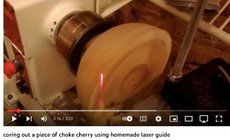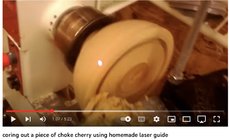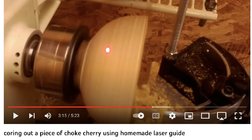I have all 3 systems, and use the McNaughton the most.
Oneway: Their original cutter tip is, to me, the worst cutter design ever. That is why so many are now using the Hunter tip. I did take one of their blanks for their cutter before that cutting tip was ground into it, ground it to a trapezoid shape, wide at the nose, and narrow where it sits on the arm, and it cut far better and easier than their standard tip and you didn't have to take it off to sharpen it. This system is rock solid, all the way out to the tip of the biggest blade they make. Most of us only think of having the pivoting center, pretty much centered on the lathe bed. By moving it to either side, you can greatly change the trajectory to get flatter or deeper cores. If you get much off to the sides, you can run into binding issues since the curvature of the support finger is fairly specific to certain diameters. It isn't difficult to move the set up a bit to one side or the other to open up the kerf.
Woodcut: I have had the 2 blade system for a while, and did like it. It was prone to chattering a bit on harder woods. I do have the 3 blade system, but haven't gotten it set up and used. They did greatly beef up the plate it sits on. It does require you to use the tailstock as part of the stabilizing process. It is a simple and efficient system.
McNaughton: Every one who has ever tried to use it swears at it. Every one who knows how to use it swears by it. I once turn my bowls. I can take the first core in less time than it takes me to set up the Oneway or the Woodcut. I used to be able to core a 13 by 6 inch blank, 4 bowls, and finish turn those bowls in about 50 minutes. There are 2 problems with learning how to use it. One is that since it is not on a pivoting center, you have to do the aiming. I probably should update my video on it. Watching Mike Mahoney at the Oregon Woodturning Symposium last weekend, like me, he uses the medium curve blade for 90% of his coring. The second problem is with the blades themselves. You don't have to look very closely to see that the last inch or so of each blade tends to go straight, rather than follow the curve of the particular arc. My guess is that they are profiled first, meaning the rounded edges top and bottom, and then bent. It is pretty much impossible to get enough pressure on them to get the tip to follow the curve. I have one blade that I hammered and tweaked till it was pretty close, and it actually drifted to the inside of the cut. As they come, they always drift to the outside of the cut as you core. Not much of a problem for more shallow cores. Big problem when going deep. You do have to open up the kerf since the blade will bind in the cut. Usually open up to the outside of the bowl. I guess a 3rd problem would be height adjustment. They tell you to set it with the longest blade, lift the handle against the top of the stop thing, and that is the correct height. Well, no. There is a lot of 'flex' built into the system. If you have ever tried to remove the stub left when you break out the core, once the blade engages that stub, it drops considerably. I start mine at about 1/4 inch above center, and for deeper cores, this is not enough. I have learned to 'feel' when that cutter is below center, and adjust accordingly. My guess is that this is the main reason some have so many catches near the bottom of the core. I do use a stop collar around the post of the tool rest, end grain turned and drilled out for the post. This makes sure it stays in place. I have a video out on how to use it, and Dale Bonertz has one as well. There are others. None of the other systems will tend to drift as you cut. I have talked to Kel McNaughton a couple of times about this issue, and he insists the blades are spot on. For me, I don't have to lay them on a circle template to check out the curve. I have often thought about using a torch and metal forms to persuade the blades into the perfect arc. I don't think that would be good for the laminate that is used for the cutting edge. I have retipped a couple of my blades with tantung. That does work great.
Oh, for sharpening the Woodcut and the McNaughton, I use a coarse diamond card and a couple of swipes across the bevel to raise a burr. They are scrapers, and scrapers usually need a burr for best cutting.
robo hippy



